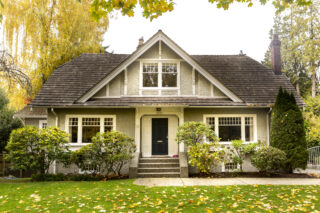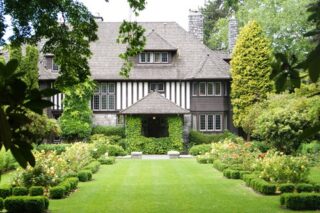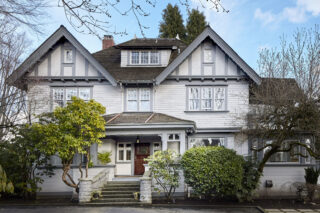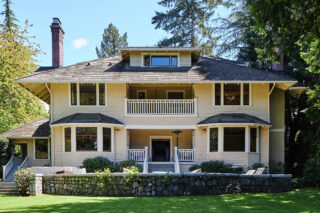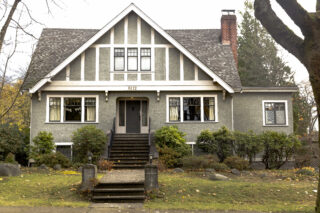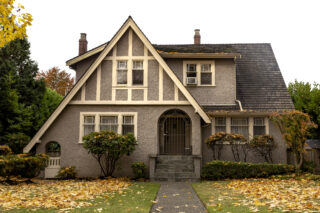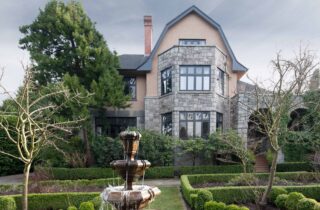The use of local materials was encouraged by Arts and Crafts principles. In Vancouver, this included wooden shingles, siding and trim, as well as brick, stone and stucco. Many of the homes have smooth stucco surfaces with little applied decoration, though some include ‘Tudor’ half-timbering and medieval detailing. Lower floors of some Arts and Crafts homes can be ornamented with brick, similar to Tudor Revival styles.
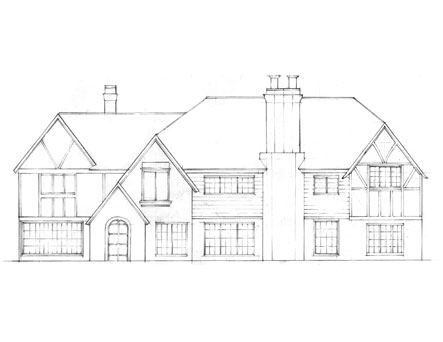
Click on the diagram or expand the term index to learn more about the features.
Cladding
Also referred to as siding, cladding is the outermost layer of the wall system, providing resistance to the natural elements and acting as a control device for drainage. Depending on the house style, various kinds of stucco, horizontal and vertical boards may be used as cladding. Types of cladding/siding: Board and Batten Clapboard Drop Lap Masonry Shakes Shingle Shiplap Stucco
Gable Roof
A pitched roof that ends in a gable (the triangular portion of a wall defined by the sloping edges of the roof and a horizontal line between the eave line).
Half-timbering
Decorative trim boards used in conjunction with stucco cladding to evoke medieval half-timbering.
Hipped Roof
A hip (or hipped) roof slopes down to the eaves on all four sides. Although a hip roof has no gable ends, it may have dormers or connecting wings with gables. When the building is square, the hip roof is pointed at the top like a pyramid. When the building is rectangular, the hipped roof forms a ridge at the top.
Leaded Glass
Decorative glass where each pane is set between cames (slender grooved bars of lead).
Form
Arts and Crafts houses are symmetrical and picturesque with steeply pitched hipped roofs, mostly built pre-WWI. Arts and Crafts houses are usually set low to the ground and often feature multiple and prominent chimneys and half-timbering on their upper floors. Windows are typically leaded glass in small panes, often set in multiple assemblies. They are in the English Arts & Crafts tradition, while Craftsman houses come from the American Arts & Crafts tradition. Architect Samuel Maclure’s grand mansions of the Edwardian era are the best representatives of the Arts & Crafts Style in British Columbia. They have more of a “sheltering roof,” more of a horizontal form, than Tudor Revival Style houses.
Background
An English movement beginning in the early 20th century, Arts and Crafts designs responded to changes brought about by rapid industrialization. The movement encompassed artistic, ideological, and political elements, which translated into a style. In architecture, Arts and Crafts encouraged the use of simple forms, relation to the environment, and natural materials. It celebrated craftsmanship with a return to earlier materials and techniques. Inspired by the writings of English thinker John Ruskin, William Morris was one of the leading proponents of Arts and Crafts. He commissioned the first Arts and Crafts building in England. From there, the style spread and established itself in North America. In Vancouver, the Arts and Crafts style is most often seen in stately homes of the wealthy. They are sometimes confused with half-timbered Tudor Revival buildings.
Between WWI and WWII, the Arts and Crafts movement style shifted to expressions in a smaller scale, the Interwar Arts and Crafts.
Details
- Steeply pitched hipped roofs
- Horizontal profile
- Multiple prominent chimneys
- Half timbering on upper floors
- Windows typically made up of small panes
- Windows in multiple assemblies
Compared to Tudor Revival styles:
- Arts and Crafts houses are set closer to the ground than Tudor Revival houses and more sheltering roof (living spaces in the roof – ie. dormer), fewer gables, interior chimneys

